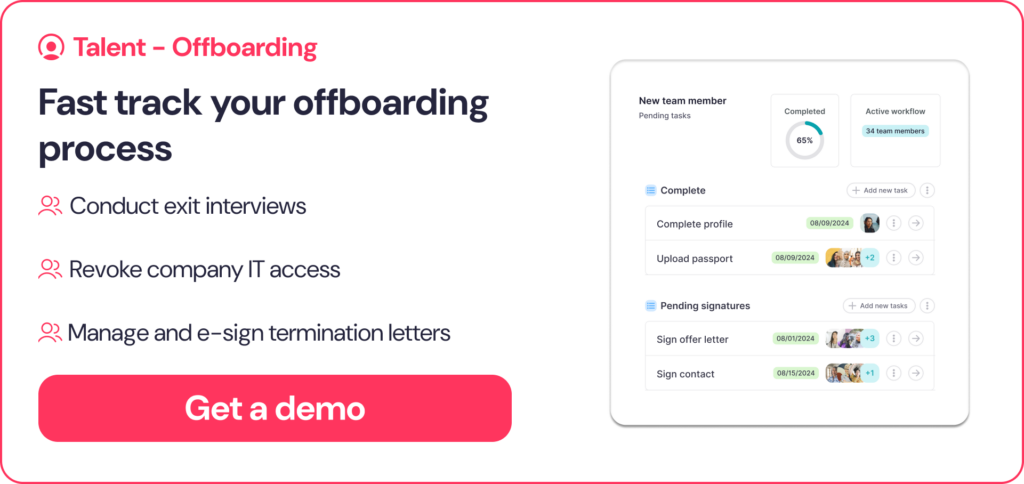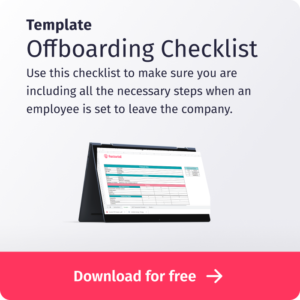There have been recent changes to the New Jersey WARN Act. Read this article to get up to date on who is protected and when a notice letter needs to be given to employees in New Jersey. The goal of the New Jersey Worker Adjustment and Retraining Notification (NJ WARN) Act is to make sure workers are looked after during big layoffs and when plants close down. Find out how these changes affect both employers and employees in New Jersey.
TABLE OF CONTENTS
- What is the WARN Act in New Jersey?
- NJ WARN Act Requirements
- New Jersey WARN Act Triggers
- New Jersey WARN Act Minimum Number of Employees
- New Jersey WARN Act Exceptions
- What Must a New Jersey WARN Notice Letter Contain?
- How to offboard during layoffs
- Offboarding software for companies 🚀
What is the WARN Act in New Jersey?
The New Jersey WARN (Worker Adjustment and Retraining Notification) Act, along with its federal counterpart and other state versions, puts responsibilities on larger employers when there are big layoffs or plants closing down. They are obligated to give their workers prior notice before a mass layoff or plant closing. The main goal is to give employees enough time to get ready for big changes in their employment status and to keep their source of income secure. If employers don’t follow the rules and give enough notice, they might have to pay affected workers compensation.
Some states like California, New York, New Jersey, and Illinois have their own mini-WARN acts. Other states, without their own set of regulations, follow the rules set by the federal WARN Act.
Related: New Jersey Minimum Wage
The Business Management Software your growing company needs.👇

New Jersey WARN Act Requirements
As of April 10, 2023, amendments to the NJ WARN Act have introduced significant changes, expanding the scope and obligations for employers. According to proponents of the law, the measure was inspired by the collapse of several large-scale retail giants like Toys-R-Us. After filing for bankruptcy in 2017, Toys R Us laid off roughly 2,000 New Jersey workers, some of whom received severance pay only after gaining outside support from advocacy groups and politicians.
Key changes to NJ WARN Act 2023:
1. Employer Size: NJ WARN now applies to employers with at least 100 employees nationwide, without regard to full-time or part-time status, years of employment, or hours worked per week. This represents a departure from the previous exclusion of part-time employees or those employed for less than six months.
2. Trigger change: The trigger for NJ WARN is now the termination of 50 or more employees in a 30-day period who “report to” a place of employment. Multiple layoffs within a 90-day period will be aggregated unless the employer can demonstrate separate causes for each round of layoffs. This marks a significant shift from the previous trigger of 500 or more employees or 50 or more employees representing 1/3 of full-time employees at an establishment.
3. Establishment meaning: The term “Establishment” now includes all locations within New Jersey. Consequently, NJ WARN may be triggered by the termination of 50 employees working anywhere in the state, regardless of their location within or outside New Jersey.
4. Extended Notice Period: The notice period has been increased to 90 days, up from the previous 60 days.
5. Severance Pay: Employers are now required to pay one week of severance for each year of service to each terminated employee automatically. Unlike the previous requirement, this severance is not conditional on the employee’s execution of a release of employment claims.
6. Additional Severance for Lack of Notice: If the 90-day notice is not given, employers must pay an additional four weeks of severance to each terminated employee.
7. Waiver Restrictions: Employees may not waive their right to severance pay under NJ WARN without state or court approval.
New Jersey WARN Act Triggers
The amendments to the NJ WARN Act redefine the triggers for employer obligations, making it essential for employers to understand when NJ WARN comes into effect.
Specifically, a qualifying event includes the termination of 50 or more employees in a 30-day period who “report to” a place of employment. This can be aggregated for multiple rounds of layoffs within a 90-day period.
NJ WARN Act Definitions
Let’s take a look at some of the important terms we need to define to avoid confusion.
Mass layoff definition
- “Mass layoff” defined as a reduction in force unrelated to a transfer or termination of operations
- Results in the termination of employment at an establishment within a 30-day period
- Involves 50 or more employees at or reporting to the establishment
Mass layoff Exclusions:
- Mass layoff necessitated by a fire, flood, natural disaster, national emergency, act of war, civil disorder, or industrial sabotage
- Decertification from participation in the Medicare and Medicaid programs
Read the official documentation of changes to the NJ Warn Act Laws here.
New Jersey WARN Act Minimum Number of Employees
As of the recent amendments, the NJ WARN Act applies to employers with at least 100 employees nationwide, regardless of full-time or part-time status, years of employment, or hours worked per week. This is a departure from the previous exclusion of part-time employees and those employed for less than six months.
New Jersey WARN Act Exceptions
While the NJ WARN Act imposes substantial requirements on employers, there are exceptions to be aware of. The severance pay requirement may be satisfied in whole or in part by payment of severance, back pay, or penalties under other WARN Acts, agreements, or collective bargaining agreements.
What Must a New Jersey WARN Notice Letter Contain?
In compliance with the NJ WARN Act, a notice letter must be issued to affected employees and include details about the impending layoff or closure, the reasons for the action, the number of employees affected, and the effective date. Employers must now also be mindful of the mandatory severance pay provisions when crafting these notices.
In conclusion, New Jersey’s recent amendments to the WARN Act introduce substantial changes that employers need to navigate. The expanded scope and increased obligations require careful consideration and compliance to ensure the well-being of affected employees and avoid additional financial consequences for the employer. Employers conducting layoffs impacting New Jersey employees should thoroughly review their plans and policies to align with the amended NJ WARN Act.
How to offboard during NJ layoffs
Navigating the New Jersey WARN Act is critical for HR managers. Compliance ensures a fair and transparent process during times of significant workforce changes. By understanding the requirements, protecting the rights of employees, and fostering open communication, HR professionals can successfully navigate the complexities of the NJ WARN Act, contributing to a positive workplace culture and maintaining compliance with federal and state regulations. Once employees have been notified of upcoming layoffs, the next big task is beginning the employee offboarding process.
Offboarding with Factorial:
Factorial simplifies the offboarding process, streamlining tasks and ensuring a smooth transition for departing employees. With Factorial, you can efficiently manage exit procedures, such as collecting company assets, updating access permissions, and conducting exit interviews. Offboarding software simplifies the entire process from start to finish.
Key Features for offboarding during layoffs:
1. Clear Communication: Easily communicate departure details to the departing employee, including the last day of work, return of company property, and other essential information.
2. Task Automation: Automate offboarding tasks, such as revoking system access, updating records, and notifying relevant departments, saving time and minimizing the risk of oversight.
3. Documentation and Compliance: Ensure compliance by generating necessary documentation, such as termination letters and exit surveys, helping you maintain a comprehensive record of the offboarding process.
4. Access Control: Centralize access control management, making it simple to revoke access to company systems and confidential information, safeguarding your organization’s data.
By utilizing Factorial for offboarding, HR managers can enhance efficiency, maintain compliance, and provide a positive experience for departing employees.




